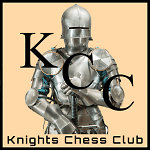
Knights Chess Club
Welcome To All, Young And Old


The History of Notation
The number of books on chess is greater than the number of books on all other games combined. Yet, chess books would be few and far between if there were not an efficient way to record the moves of games. Chess notation is thus the special written" language" of chess players, making it possible for a single book to contain hundreds of games by great players, or thousands of opening variations.
Surprisingly, however, chess notation was slow to evolve. As late as the early nineteenth century, many chess books simply wrote out moves in full sentences! As a result, very few of those early games before the 1800's were recorded and preserved in print, and published analysis was correspondingly limited.
In Shakespeare's day, for example, the standard English chess book gave the move 2.Qf3 as follows: " Then the black king for his second draught brings forth his queene, and placest her in the third house, in front of his bishop's pawne." Can we imagine recording a full 40-move game with each move written out like that!
Nevertheless, the great 18th century player and author Andre Philidor, in his highly influential chess treatise published in 1747, continued to write out moves as full sentences. One move might read, "The bishop takes the bishop, checking." Or the move e5 would appear as "King's pawn to adverse 4th." Occasionally Philidor would abbreviate something, but generally he liked to spell everything out.
In 1737, however, a Syrian-born player/author named Philip Stamma introduced the shorthand notation that we now call "algebraic" in his book of composed problems, published in France. In 1745, he issued an expanded edition in English that included opening analysis and retained the algebraic notation. Stamma's system was almost identical to modern algebraic notation, with the files of the board designated " a-h" and the ranks numbered "1-8." However, he tried to make the notation completely international by using standard piece names as well as standard letters and numbers for the squares. Thus, the king's rook was written as "H" instead of "R" throughout the game, because it began on the h-file; for similar reasons the king was always "E" and the queen "D," the queen's knight was "B," etc., with each piece being named for its starting file.
That system for piece symbols would have totally eliminated language differences across countries, but it failed and each country now uses its own piece symbols in algebraic notation although retaining standard names for the squares. Nevertheless, modern figurine algebraic ( with printed piece symbols instead of names) is coming into use as a new way of reviving Stamma's old idea of a totally international notation.
Philidor and Stamma were rivals both as players and authors. Philidor soundly defeated Stamma in a match, after which Philidor's book became more popular than Stamma's book in England and his notation system therefore became dominant. However, Stamma's book also continued to enjoy popularity, and by the 19th century Stamma's simple system had become the norm in some European countries. Thus began the battle between descriptive and algebraic notations that continued into modern times.
Clearly, however, Philidor's way of recording moves had to be made more efficient if English chess literature were to have room to grow. A major innovation in that respect occurred in 1817, when an edition of Philidor's works introduced a system of abbreviations into Philidor's ponderous notation. Those abbreviations, by the way, were introduced rather timidly with suitable apologies to the reader. Over the next few decades, more use of abbreviations occurred, and the descriptive notation of modern times slowly took shape. As notation simplified, chess books were able to include more information, and the number of chess books began to increase exponentially.
Following is a sampling of ways of giving the move N-KB3 ( Nf3 in algebraic) in descriptive notation, taken from books of different years to illustrate the slow evolution of that notation system. Notice the subtle changes that creep in virtually one letter at a time; apparently too much change could not be tolerated all at once!
1614: The white king commands his owne knight into the third house before his owne bishop. 1750: K. knight to His Bishop's 3d. 1837: K.Kt. to B.third sq. 1848: K.Kt. to B's 3rd. 1859: K. Kt. to B. 3d. 1874: K Kt to B3 1889: KKt -B3 1904: Kt-KB3 1946: N-KB3
In the 1970's, The US Chess Federation began a campaign to convert the US to algebraic notation, which had by then become standard in nearly all countries. The arguments for the change were several: that US books would then enjoy a bigger international market; that algebraic was less ambiguous and therefore produced fewer irretrievable game scores; that algebraic took less space and more games could therefore fit into fewer pages.
In spite of these persuasive arguments, a fierce battle raged for years until algebraic gradually won out. Now descriptive is on the road to becoming an extinct "language" understood in the future only by historians. We now have books containing huge numbers of games, and computers that "speak" only algebraic.
We have come a long way from " the white King commands his owne knight into the third house before His owne Bishop" to the simple "Nf3," and chess literature has come a long way as well!






